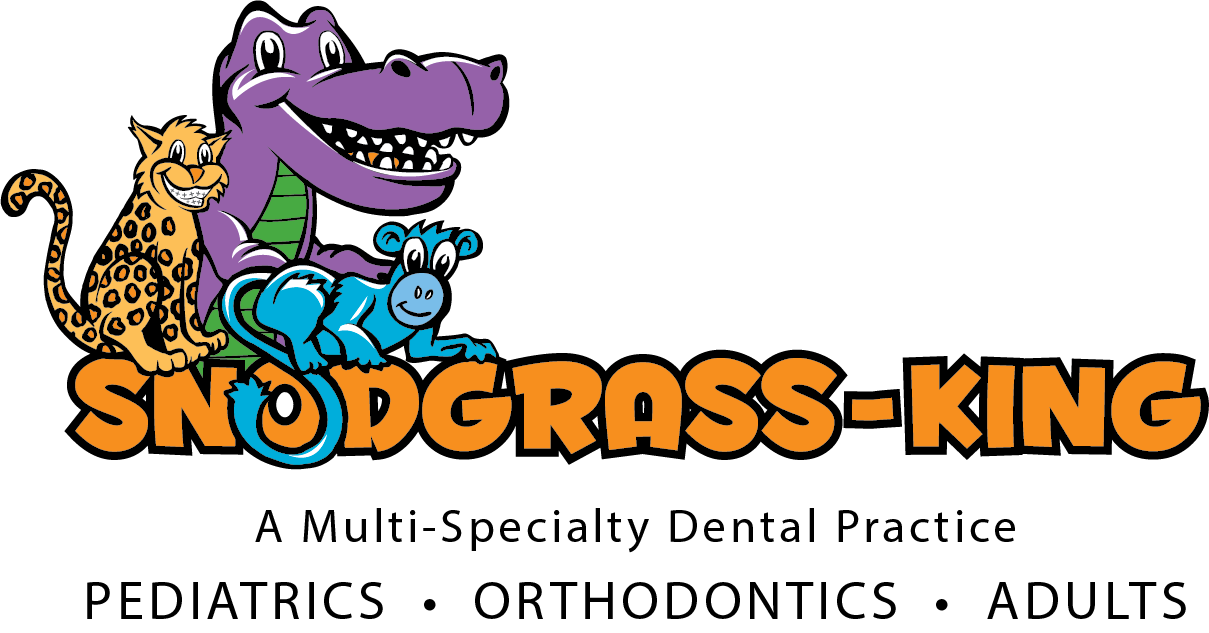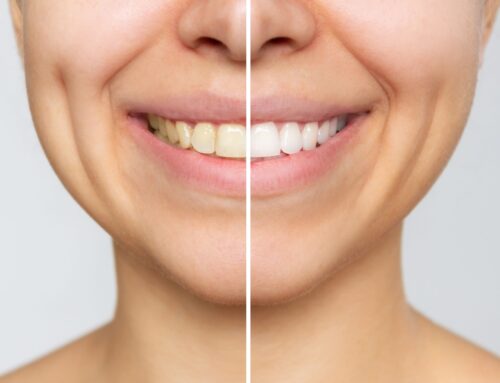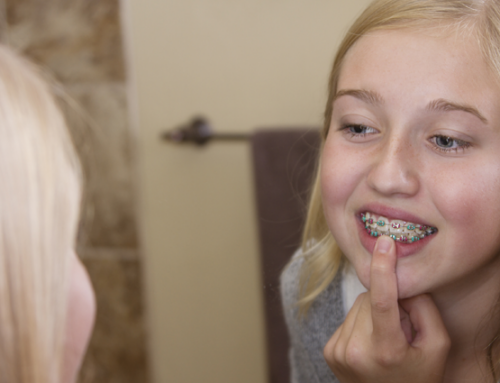6 Reasons to Get Braces as an Adult
It’s fairly common to see school-aged kids wearing braces. After all, very few people’s teeth naturally come in perfectly straight. Did you know, however, that it’s not just kids that can wear braces? In fact, more than a million adults wear braces, and the trend only continues to grow every day. Whether you are uncomfortable with your smile or have trouble with oral hygiene because of the placement of your teeth, adult braces have many benefits.
Today, 1 out of 3 orthodontic patients are adults who are looking for braces for more than straighter teeth, but better overall dental health. Let’s take a closer look at the top 6 reasons for getting braces as an adult.
1. You Have Many Options
While traditional metal braces are the norm for many braces wearers, you have other orthodontic treatment options for straightening your teeth.
For example, many working adults opt for minimally-visible braces such as clear aligners, ceramic braces, or self-ligating braces. These are all great options for adults that are wary of the impact that traditional braces may have on their appearance. Depending on your budget and the severity of your crooked or misaligned teeth, your dentist will offer some dental options.
In the case that your dental issue is extremely minor, you may even be able to get away with a simple retainer. Unlike braces, retainers are not meant to drastically shift your teeth. Instead, their role is more of a maintenance one. They simply keep your teeth in place. Oftentimes, you’ll only be required to wear a retainer for a certain number of hours per day (such as overnight).
Dental Aligners
Dental aligners, like Invisalign, are clear, nearly invisible, orthodontic aligners to straighten teeth. This removable alternative to braces corrects misaligned and crooked teeth by gradually shifting teeth with a series of custom, clear aligners. A 3D scanner is used to create a mold of your current teeth with additional aligners and scans needed every 2 to 8 weeks depending on the severity of your case. You will visit your orthodontist for the scans and to receive your new aligners. In some cases it can take as little as 4 months to see results from dental aligners, like Invisalign. While for other scenarios, it may take up to 2 years for final results.
Lingual Braces
Lingual braces are hidden braces that sit on the back of teeth. These braces work the same as traditional braces to straighten teeth but are less visible.
2. You Get More Than Straight Teeth
As you age, your mouth and jaw change shape. Your jawbone naturally loses density, which causes your teeth to shift. Over time, your teeth become crowded, and you experience pain or discomfort when chewing and swallowing. Teeth that overlap also become difficult to keep clean, making your teeth more susceptible to dental decay. Remember, healthy teeth should be spaced evenly apart, allowing for thorough brushing and flossing.
Braces not only straighten your teeth to give you a more natural smile, but they also improve your overall oral health. Many patients who get braces are over 50 years of age, choosing to get braces due to oral discomfort.
3. You Gain Confidence in Your Smile
You gain confidence in your smile when you get braces because you no longer have to feel self-conscious about the way your teeth look. Everyone deserves to feel beautiful in a photo. Your smile should always be a benefit, not a hindrance. Write down your concerns about your teeth and discuss them with your dentist to see if adult braces are a good solution for your dental needs.
4. You Have Affordable Treatment Options
Braces are not as expensive as you think. The average adult spends anywhere from $5,000 to over $7,000 to pay for braces. If you need braces for reasons beyond cosmetics — such as preventing dental decay or improving the way you speak and eat — your dental insurance may even help cover your costs.
Check with your insurance company to find out if you have orthodontics coverage, many dental plans do. If you do not have dental benefits, there are payment plans available through various medical lending companies.
The costs for adult braces vary depending on the type of braces you need. Lingual braces are often pricier than traditional braces. Your dentist will show you the braces options best for your oral needs and budget.
Don’t forget: although braces are a financial investment, they pay off over the course of your entire life.
5. You Won’t Wear Braces Forever
The average adult wears braces anywhere from 18 to 26 months. How long you will wear braces depends on the style of braces you choose, how crooked your smile is, and other factors. Your dentist will adjust your braces every several weeks as your teeth respond to treatment. After the dentist removes your braces, he or she will have you fitted for a retainer to align your new smile.
After receiving braces, your mouth will feel sore, and eating and speaking will be uncomfortable while you get used to your dental wear. Your dentist will show you ways to take care of your teeth while wearing braces to keep your oral health in check.
6. Braces May Be Medically Necessary
For many people, braces are seen as a rite of passage during adolescence. However, braces are not just for teenagers—they can also be beneficial for adults. In fact, braces can be medically necessary for some adults.
Here are some common dental conditions which may require braces:
- Underbite
- Teeth Gaps
- Overbite
- Over-crowding
- Jaw-related conditions (such as TMJ)
It’s important to correct conditions such as these, since they can worsen over time. Unfortunately, teeth misalignment rarely corrects itself. Braces are often required to push the teeth into an evenly spaced formation. Remember that in severe cases, untreated misalignment can lead to even more serious dental conditions.
It’s also important to consider quality of life when talking about braces. Even if your teeth misalignment doesn’t cause further dental problems, it can decrease your quality of life overall. Consistent pain and discomfort in the jaw will make sleeping and eating more difficult. Braces can often relieve pain caused by TMJ disorders, teeth grinding, or overcrowding. Therefore, braces may be recommended by your dentist or orthodontist in order to tackle these issues.
Ideal Candidate for Adult Braces
If you are an adult in good overall health but have crooked teeth, you may want to consider a consultation with an orthodontist.
During your braces consultation at Snodgrass-King we can determine if you will benefit from orthodontic treatment. You may be a good fit for braces if you have one or more of the following conditions:
- Crossbite
- Underbite
- Overbite
- Overcrowded teeth
- Generally crooked teeth
- Shifted teeth
These common bite problems are mostly influenced by your genetics and how your jaw develops. If you have a small jaw, your teeth are more likely to crowd and become crooked, especially after you lose your primary teeth. Other problems come from the size and shape of your mouth. Your dentist may use x-rays to identify any additional problems.
How Orthodontic Treatments Like Braces Are Effective for Adults
Many orthodontic problems can be corrected as easily for adults as for children, since healthy teeth can be moved at any age. Orthodontic devices move teeth the same way for both adults and children.
However, the major difference between child and adult orthodontic treatment is that adult bones are no longer growing. This means that it may take a little longer for adult teeth to move into their correct position.
Orthodontic treatments can help with:
- Periodontal problems
- Prevent or reduce further bone loss around teeth
- Ability of the dentist to restore missing teeth
- Aesthetics for a better smile and facial appearance
- Function of teeth
- Self-confidence and self-esteem
- Oral health
How Should I Brush My Teeth With Braces?
Whether you’re an adult or a child, the technique for brushing around your braces is the same. Instead of brushing your teeth with your mouth closed, you want to make sure your jaw is open. When you brush, take care to brush both above and below the bracket on the tooth. Keeping your jaw open will help you remember to brush both above and below.
You should never brush your teeth with a back and forth motion, doing so will wear away your gums and cause more problems later on. Instead, you should make tiny circles and use an extra-soft toothbrush to keep your gums clean and strong while you have braces.
For a more visual demonstration, here is a handy video from one of our dental professionals, so you can see exactly how to brush your teeth while you have braces.
Will My Insurance Cover the Cost of Braces as an Adult?
Our division of insurance specialists is committed to helping you get the best possible dental care for your family. If your insurance plan covers braces, then we will do our best to work with any kind of dental insurance.
But, Don’t Braces Look Funny on Adults?
You’re not in middle school anymore so the window of time that you can get braces has passed, right? Not exactly!
Adult braces are actually much more common than you think. Approximately 4 million Americans wear braces, and 25% of them are over the age of 18. Today, there are subtler and less visible options for braces that oftentimes make you more comfortable starting your adult orthodontic treatments.
Adult Braces FAQs
Do Braces for Adults Have to Show?
Many options are available today to minimize the appearance of braces. Today’s braces are smaller and sleeker, and some are next to invisible. Adolescents and adults have more choices than ever in creating a beautiful smile. From traditional braces to clear orthodontic alternatives, the number of effective and cosmetically pleasing treatment options is growing all the time.
Do Childhood Habits Cause Crooked Teeth in Adults?
Most causes for crooked teeth are a result of myofunctional habits. Specifically, these habits include tongue thrusting, reverse swallowing, thumb sucking, and mouth breathing. These habits put pressure on baby teeth and gums during childhood. If not corrected, they will cause more problems.
Even if corrected, these habits can hinder healthy dental development. If you have a history of any of these habits, you may be a good candidate for adult braces.
After carefully analyzing the nature of your needed correction, your orthodontist will recommend the best course of treatment for improving your smile.
How Do I Know If I Need Braces?
Visit us at Snodgrass King for a consultation! During your consultation, your orthodontist can determine if you will benefit from treatment. After the doctor analyzes the condition of your mouth and teeth, they will recommend a course of treatment to give you the smile you deserve!
Looking for Braces or Adult Dentistry in Tennessee?
Braces can change your life and improve your overall health and oral hygiene. If you’re in need of braces or dental cleanings, connect with us at Snodgrass-King Dental Associates.
The best part about our practice is that we offer a wide range of services for both children and adults. This means that you can get your teeth cleaned and whitened, while your child gets their sealants and cavity fillings. Our team has experienced dentists specializing in all kinds of patients. Whether you’re booking your first appointment, or your child’s, you’ll be in good hands.
Snodgrass-King offers adult dental services in downtown Franklin, Spring Hill, Murfreesboro, and Mt. Juliet in Tennessee. So whether you live in Davidson County, Williamson County, or Rutherford County, visit Snodgrass-King Family dentistry for all your adult and pediatric dental needs.
To book an appointment, simply call or fill out our online form. In the meantime, feel free to check out some patient info on our website. Here, you can find new-patient forms and insurance info. If you’d like to learn more about dentists before booking your appointment, feel free to head over to one of our “Meet the Doctors” tabs. There, you can get to know some of the awesome team members that will be taking care of your teeth.
Don’t miss out on our new patient specials! We look forward to connecting with you and seeing your beautiful smile!
One Last Note on Adult Braces from Dr. Roedig
Watch Dr. Jason Roedig explains that braces are not just for children. While the American Association of Orthodontics does recommend that children start seeing an orthodontist at age 7, it doesn’t mean an adult is too late if orthodontic work would be beneficial. It is possible to start improving your smile at any age!





